Introduction: The Magic of Japandi Style
Ever walked into a room and instantly felt peaceful? That’s what a Japandi bedroom can do for you. Japandi—a fusion of Japanese minimalism and Scandinavian coziness—has taken the design world by storm, and it’s easy to see why. It combines the best of both worlds: the warm functionality of Nordic design with the elegant simplicity of Japanese aesthetics.
In this guide, we’ll explore 11 stunning Japandi bedroom ideas that’ll transform your sleep space into a serene sanctuary. Whether you’re starting from scratch or just looking to refresh your current setup, these tips will help you create that perfect blend of form and function that the Japandi style is known for.
Let’s dive into how you can bring this harmonious style into your bedroom tonight!
What Makes Japandi Style Perfect for Bedrooms?
Before we jump into specific Japandi bedroom ideas, let’s understand why this style works so well in sleeping spaces.
Bedrooms should be havens of tranquility—places where you can escape the chaos of daily life and truly relax. Japandi style naturally creates this calm atmosphere through:
- Clean lines that don’t overwhelm the senses
- Natural materials that connect you to the earth
- Uncluttered spaces that let your mind rest
- Warm neutrals that soothe rather than stimulate
The Japanese concept of “wabi-sabi” (finding beauty in imperfection) meets the Scandinavian idea of “hygge” (creating comfort and contentment). The result? A perfectly balanced bedroom that feels both sophisticated and comfortable.
Now let’s explore our 11 Japandi bedroom ideas that’ll help you create this balanced sanctuary.
11 Japandi Bedroom Ideas to Transform Your Space
1. Embrace the Neutral Color Palette
The foundation of any Japandi bedroom starts with color—or rather, a thoughtful lack of it. Neutral doesn’t mean boring! Think warm beiges, soft whites, gentle grays, and muted earth tones.
How to do it:
- Paint walls in soft beige or warm white
- Choose bedding in natural, undyed fabrics
- Add depth with different shades of the same color
- Incorporate black accents for grounding contrast
Unlike all-white Scandinavian rooms, Japandi spaces often include warmer neutrals and even soft blacks for balance. This creates a cozy yet sophisticated vibe that’s perfect for rest.
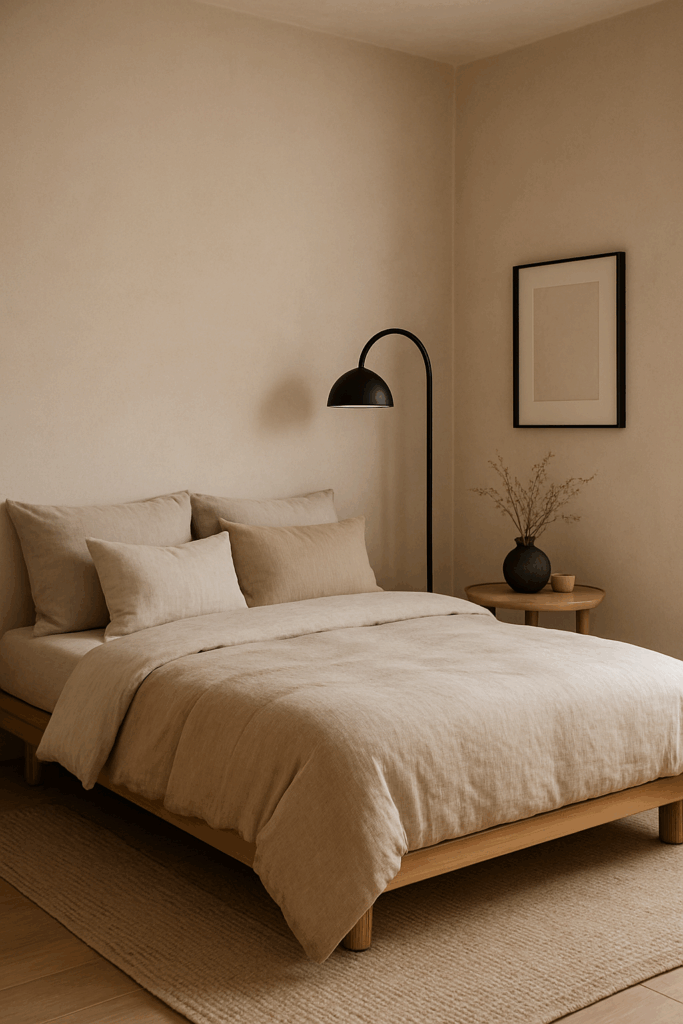
2. Focus on Natural Wood Elements
Wood is absolutely essential in Japandi bedroom design. Both Japanese and Scandinavian styles celebrate timber’s natural beauty—it’s where these aesthetics truly align.
Try these wood elements:
- A low platform bed with a simple wooden frame
- Nightstands with clean lines and minimal hardware
- Exposed wooden beams (if you’re lucky enough to have them)
- Custom-built-ins that maximize space without cluttering
The key is choosing wood with visible grain that’s finished naturally rather than painted or heavily treated. Oak, ash, pine, and walnut all work beautifully. Mix different wood tones for added dimension—just keep the overall feel streamlined.
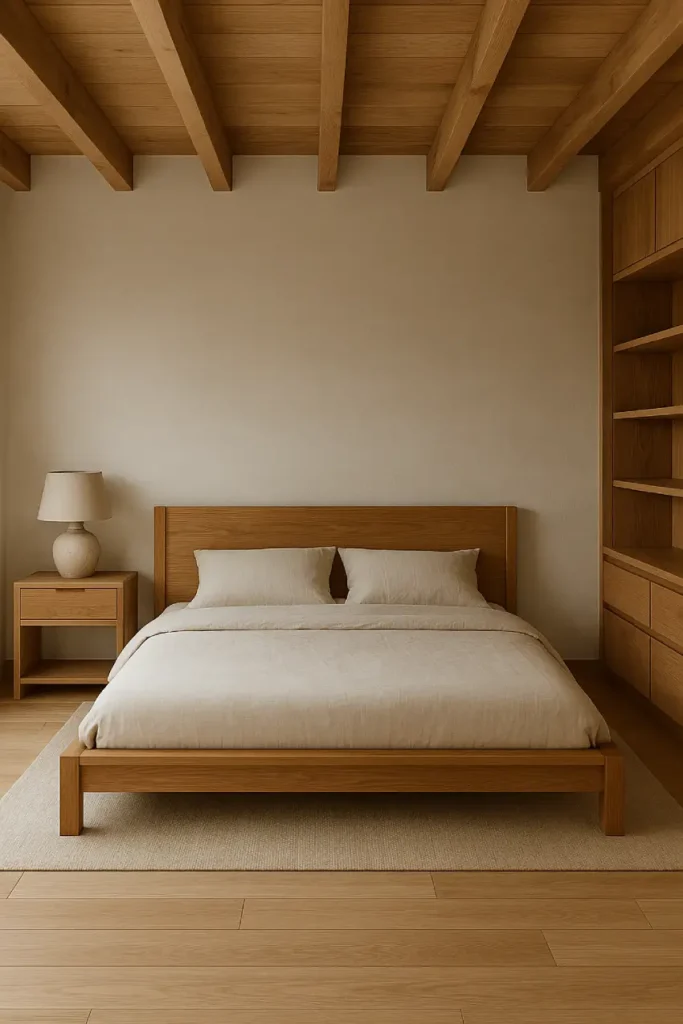
3. Layer Textures for Warmth
Japandi style balances minimalism with warmth, and texture is how you achieve that perfect middle ground. Without patterns competing for attention, different textures create subtle visual interest.
Texture ideas for your Japandi bedroom:
- Linen bedding with its naturally rumpled look
- A chunky knit throw at the foot of the bed
- Woven bamboo or rattan accents
- Rice paper lamp shades that diffuse light softly
- Tatami mats or a natural fiber rug underfoot
These textural elements add depth without complicating the clean aesthetic. They also make the space feel lived-in rather than like a sterile showroom.
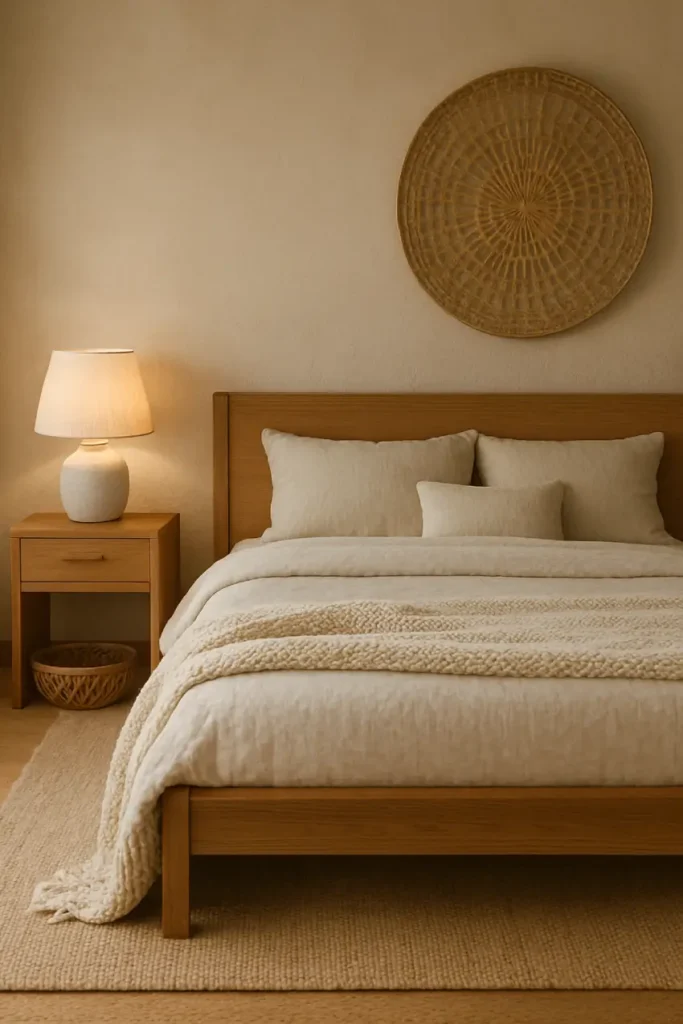
4. Choose Low-Profile Furniture
One hallmark of Japandi bedroom design is furniture that sits closer to the ground. This Japanese-inspired approach creates a grounded feeling and makes rooms appear more spacious.
Low-profile options:
- Platform beds without box springs
- Floor cushions for meditation corners
- Bench-style seating instead of bulky chairs
- Floating nightstands mounted low on walls
This furniture style feels modern yet timeless, and it encourages a different relationship with your space—one that’s more relaxed and less formal.
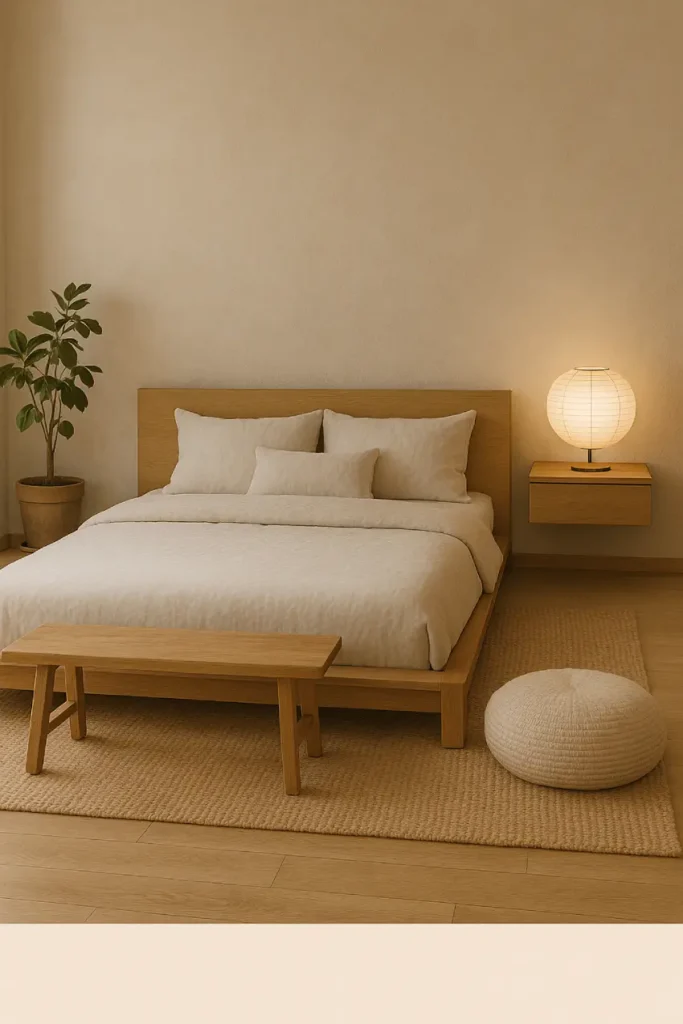
5. Incorporate Built-In Storage
Both Japanese and Scandinavian designs value functionality. In a Japandi bedroom, storage should be beautiful yet practical, helping maintain the clutter-free environment that’s essential to the style.
Smart storage solutions:
- Under-bed drawers built into platform frames
- Wall-mounted cabinets with clean fronts
- Custom closets with sliding doors (inspired by shoji screens)
- Hidden storage behind headboards
The goal is to have a place for everything, keeping surfaces clear and maintaining visual calm throughout the room.
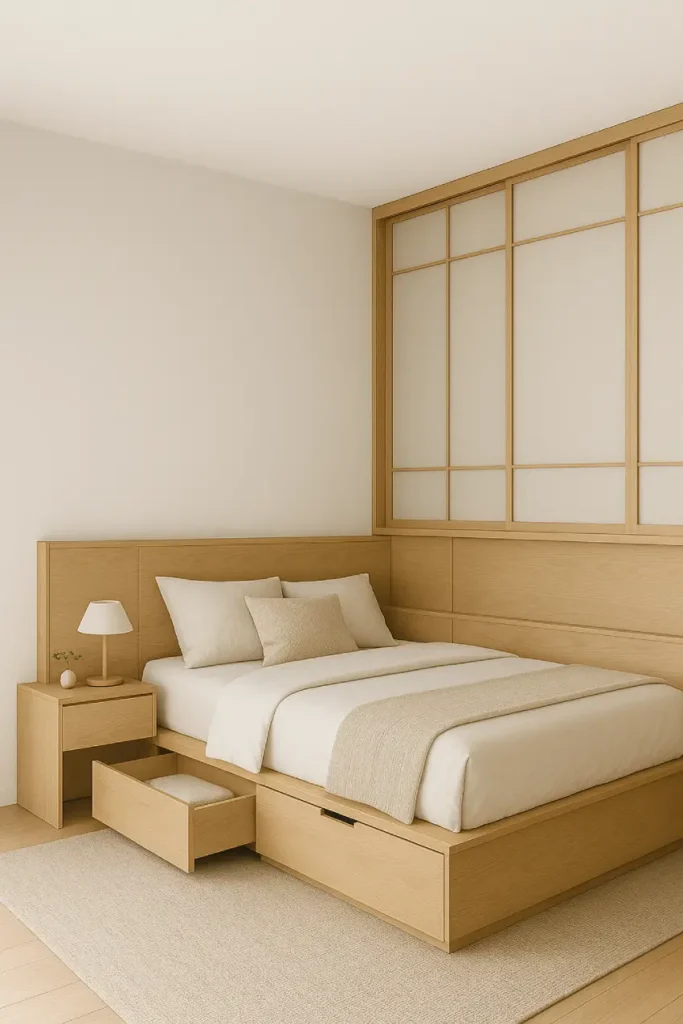
6. Bring Nature Indoors
Both cultures deeply value connections to nature, making plants perfect additions to Japandi bedrooms. Living elements soften the minimalist aesthetic and improve air quality while you sleep.
Plant ideas for your Japandi bedroom:
- A single statement bonsai on a dresser
- Bamboo in a simple ceramic pot
- Boston ferns with their delicate fronds
- Snake plants are valued for their structural quality and air-purifying benefits
Choose just a few quality plants rather than filling every corner. They should enhance the space’s serenity, not create visual clutter.

7. Create a Zen Corner
Dedicating even a small area of your bedroom to mindfulness embraces the Japanese influence in Japandi style. This “zen corner” can be a place for meditation, reading, or simply sitting quietly.
Elements for your zen corner:
- A simple floor cushion or low stool
- A small wooden table for tea
- A single potted plant
- Natural light from a nearby window
- A bamboo mat to define the space
This area doesn’t need to be large—even a 3×3 foot space can work. What matters is creating a dedicated spot for stillness within your bedroom retreat.

8. Add Thoughtful Lighting
Lighting can make or break a Japandi bedroom. The goal is soft, diffused illumination that creates a warm atmosphere rather than harsh overhead glare.
Japandi lighting ideas:
- Paper lanterns that reference Japanese design
- Simple wooden table lamps with linen shades
- Recessed lighting for ambient glow
- Candles for evening ambiance
- Wall sconces that don’t take up surface space
Layer different light sources at various heights for the most natural feel. And whenever possible, maximize natural daylight—it’s the most beautiful illumination of all.
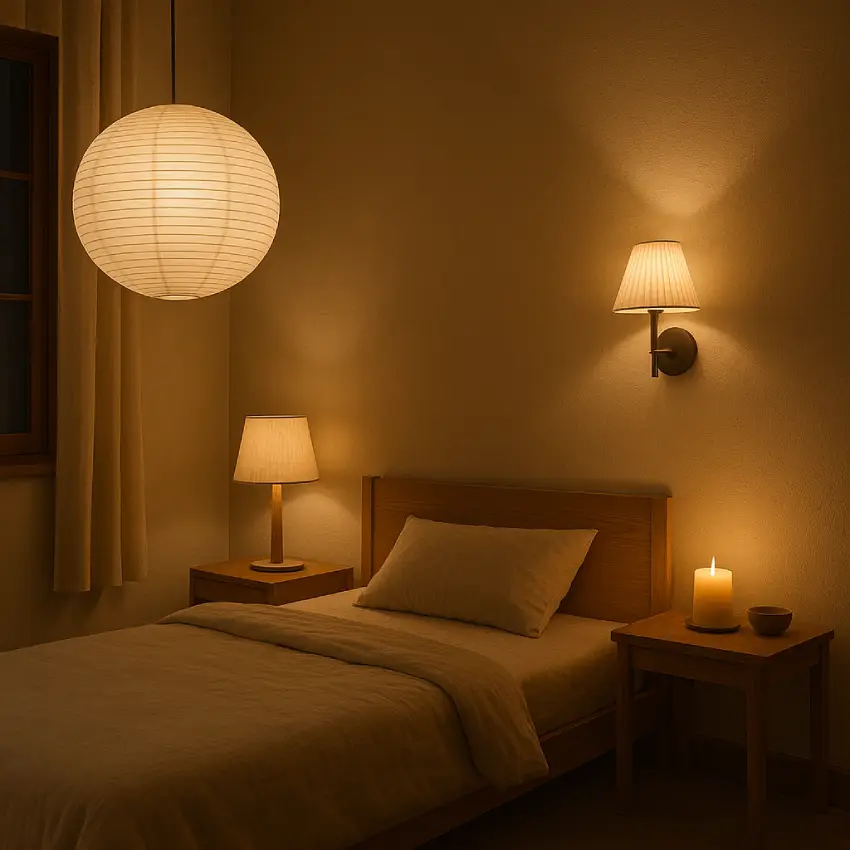
9. Incorporate Shoji-Inspired Elements
Shoji screens—those beautiful paper-and-wood room dividers from Japan—influence many Japandi bedroom designs. You don’t need actual shoji screens to capture their essence.
Modern takes on shoji:
- Sliding closet doors with translucent panels
- Room dividers for studio apartments
- Headboards with grid patterns
- Window treatments that filter light similarly
- Wall panels with simple geometric divisions
These elements add authentic Japanese character while maintaining the clean lines that both styles value.
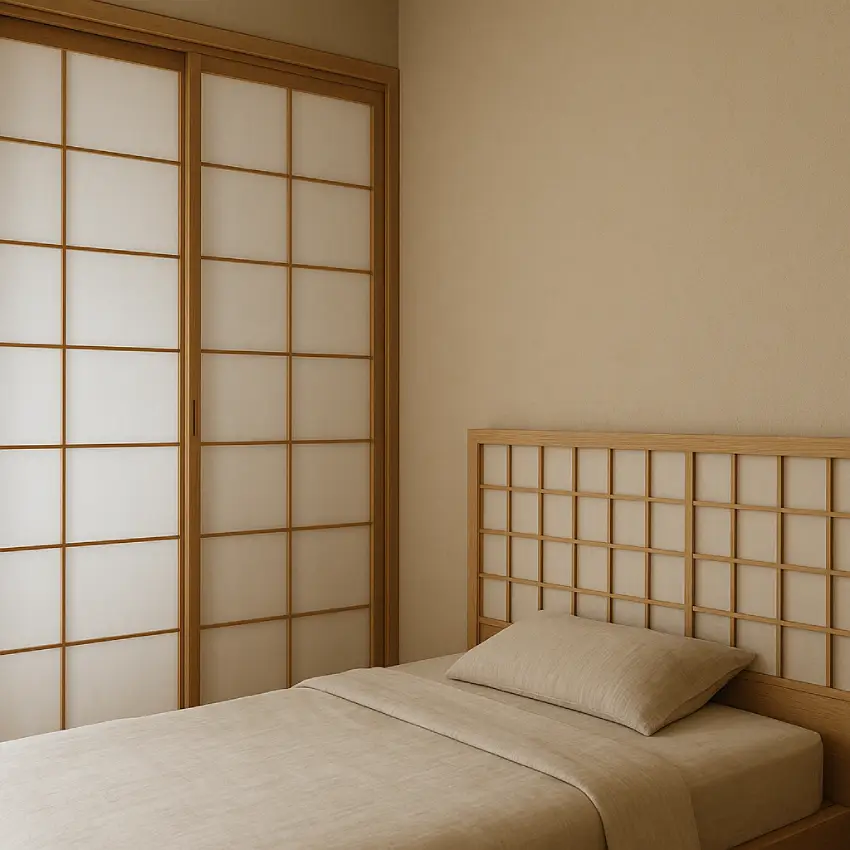
10. Focus on Quality Over Quantity
Perhaps the most important Japandi bedroom idea isn’t about what you add—it’s about what you don’t. Both Japanese and Scandinavian design philosophies value quality craftsmanship over accumulation.
How to embrace quality:
- Choose fewer, better pieces that will last decades
- Look for handcrafted items with visible craftsmanship
- Invest in natural materials rather than synthetics
- Consider the story behind each item you bring in
- Regularly evaluate what deserves space in your room
This approach not only creates a more beautiful bedroom but also a more sustainable one—something both cultures deeply value.
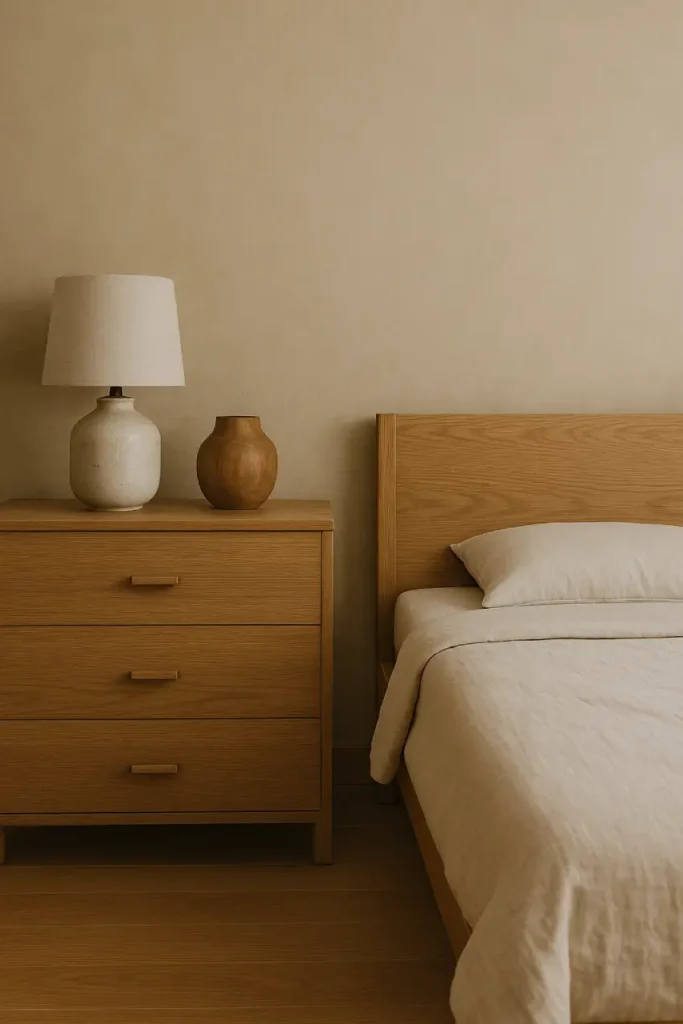
11. Balance Opposites for Harmony
The magic of Japandi style comes from the thoughtful balance between light and dark, rough and smooth, old and new. This final idea ties everything together.
Ways to create balance:
- Pair a light wood bed with darker accents
- Combine sleek modern lighting with natural textiles
- Mix handcrafted artifacts with clean-lined furniture
- Balance space with carefully chosen focal points
- Contrast rough textures with smooth surfaces
This dance between opposites creates visual tension that keeps a minimalist space from feeling boring or flat.
How to Start Your Japandi Bedroom Transformation
Feeling inspired by these Japandi bedroom ideas but not sure where to begin? Start small:
- Declutter first – Remove anything that doesn’t serve a purpose or bring you joy
- Establish your palette – Choose 3-4 neutral colors to work with
- Start with the bed – It’s the focal point of any bedroom
- Add one plant – Instant life and connection to nature
- Evaluate your lighting – Often changing this alone transforms a space
Remember, Japandi style isn’t achieved overnight. It’s about thoughtful curation and finding that perfect balance between two beautiful design traditions.
Why Japandi Style Might Be Perfect for You
Japandi bedrooms aren’t just beautiful—they’re practical and purposeful. This style works especially well for people who:
- Feel overwhelmed by too much visual stimulation
- Want to create a truly restful sleep environment
- Value sustainability and timeless design
- Appreciate craftsmanship and natural materials
- Need to maximize smaller spaces without sacrificing style
The best part? Japandi style is incredibly adaptable. You can lean more Japanese or more Scandinavian depending on your personal preferences while still maintaining that harmonious fusion.
Final Thoughts on Creating Your Japandi Bedroom
Creating a Japandi bedroom isn’t about following rules perfectly—it’s about capturing the essence of two traditions that value simplicity, nature, and mindful living. Use these 11 Japandi bedroom ideas as inspiration, but make the space uniquely yours.
The true test of successful Japandi design is how you feel when you enter the room. Does tension melt away? Does your breathing slow down? Do you feel both energized and calm? If so, you’ve captured the elusive balance that makes Japandi style so special.
